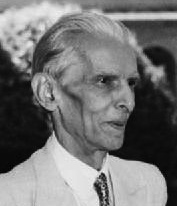All-India Muslim League
![]()
This article is about the Pakistani party and its origin in India. For the Muslim League in India today, see Indian Union Muslim League. For the German organization, see German Muslim League.
The All-India Muslim League (Urdu آل انڈیا مسلم لیگ Āl Inḍīya Muslim Līg, English All-India Muslim League), abbreviated as Muslim League (مسلم لیگ Muslim Līg), was a political party of Muslims in India founded in 1906. It was instrumental in the preparations for the creation of an independent state of Muslims, which led to the partition of India in 1947 and the creation of the state of Pakistan.
When Pakistan was founded, the Muslim League there succeeded the All-India Muslim League and became one of the most important political parties in Pakistan: from 1947 to 1958 under the name Muslim League and after a re-establishment from 1962 to 1988 as Pakistan Muslim League.
Since 1962, the Pakistan Muslim League has experienced a series of splits and various attempts to reunite the groups. In 1988, the Pakistan Muslim League (N) was formed as a separate and independent party from the Muslim League, led by Nawaz Sharif from 1993 to 2018. Today, it is the strongest of the successor parties by a wide margin. With 189 of 342 seats, it was the dominant party in the National Assembly until the 2018 general elections.

Flag of the All-India Muslim League
Muslim League in British India
The All-India Muslim League was founded in Dhaka in 1906. Mohammed Ali Jinnah was elected president of the Muslim League in British-ruled India in 1916. This developed into a party that increasingly split from the Indian National Congress from 1936 onwards and worked towards the establishment of an independent state for Muslims. In this context, Jinnah drafted the so-called Lahore Resolution in 1940. In the negotiations with the British on the independence of India, he pushed through the partition of the Indian subcontinent into the predominantly Hindu India and the Muslim state of Pakistan in the Indus Valley and the mouth of the Ganges in 1947. In the wake of the partition, over 4 million Muslims left what is now India, while about 7 million Hindus and Sikhs left the territory of Pakistan. It is estimated that up to 750,000 people lost their lives in acts of violence and due to the hardships during the flight.

Mohammed Ali Jinnah became the first president of the Muslim League in 1916
Muslim League in Pakistan
Muslim League (1947-1958)
Jinnah was also the first head of state of Pakistan in 1948 until his death. In 1954, the Muslim League, which had ruled Pakistan until then, lost to the opposition Awami League in the regional elections in East Pakistan. Iskander Mirza was installed as governor of East Pakistan. On March 23, 1956, Pakistan's first constitution came into effect, and Mirza became the first president of the Islamic Republic of Pakistan. Martial law prevailed in Pakistan between 1958 and 1972.
Pakistan-Muslimliga (1962-1988)
In 1971, after the defeat of (West) Pakistan in the war of secession against Bangladesh (the former East Pakistan), Zulfikar Ali Bhutto's Pakistan People's Party (PPP) came to power. In 1977, after protests by the Pakistan Muslim League and the Pakistan National Alliance (PNA), the commander-in-chief of the armed forces, General Mohammed Zia ul-Haq, staged a coup.
Spin-offs
Various groups have directly or indirectly split from the Pakistan Muslim League, including:
- Pakistan Muslim League (F), short PML-F - Functional Muslim League: founded 1985
- Pakistan Muslim League (N), short PML-N - N for Nawaz group: founded 1988
- Pakistan Muslim League (J), PML-J for short - J for Junejo tribe: founded in 1993, merged into PML-Q in 2004 through reunification
- Pakistan Muslim League (Q), short PML-Q - Q for Quaid-e-Azam group: founded 2002
- Pakistan Muslim League (Z), short PML-Z - Z for Zia-ul-Haq group: founded 2002
- Awami Muslim League: founded in 2008
- All Pakistan Muslim League: founded in 2010 by Pervez Musharraf
After the death of Zia ul-Haq in August 1988 and the election victory of the PPP under Benazir Bhutto, the Muslim League-dominated party alliance "Islamic Democratic Alliance" under its leader Nawaz Sharif won the elections in October 1990. After his ouster in 1993, Benazir Bhutto became prime minister again. In the 1997 parliamentary elections, the Muslim League won an absolute majority. On October 12, 1999, Nawaz Sharif was deposed by Chief of Army Staff Pervez Musharraf in a bloodless coup.
In the 2002 parliamentary elections, a Muslim League splinter group close to President Pervez Musharraf, the Pakistan Muslim League Quaid-e-Azam (PML-Q), became the strongest faction. Nawaz Sharif's Muslim League (PML-N) was only a splinter party.
In the 2008 parliamentary elections, however, the PML-N became the second-strongest force behind the PPP in the National Assembly. In March 2009, the PML-N and numerous lawyers called for several days of protests against government policies. A "Long March" on the capital Islamabad was to demonstrate for an independent judiciary in Pakistan. On March 15, 2009, severe riots broke out between Sharif's supporters and the police in Lahore. After the Pakistani government gave in to the opposition's main demand and announced the reinstatement of several judges, including former Chief Justice Iftikhar Muhammad Chaudhry, Sharif cancelled the "Long March".
In the parliamentary elections in Pakistan on 11 May 2013, Nawaz Sharif, as the PML-N's leading candidate, unexpectedly won at least 130 of the 371 parliamentary seats up for grabs. He was particularly successful in his home province of Punjab. On June 5, 2013, he was again elected prime minister.
On July 30, 2013, Mamnoon Hussain, PML-N candidate, won the presidential election in Pakistan.
Search within the encyclopedia